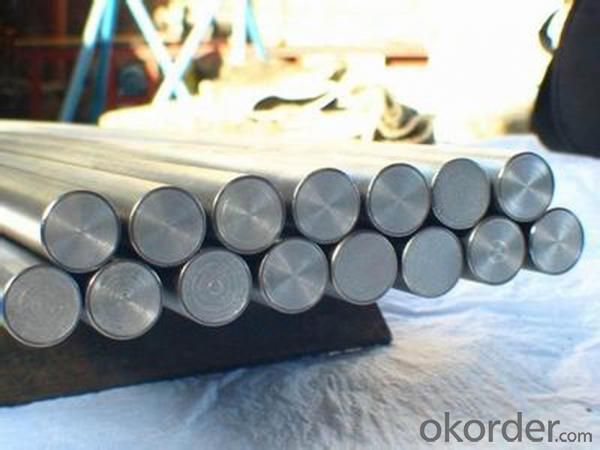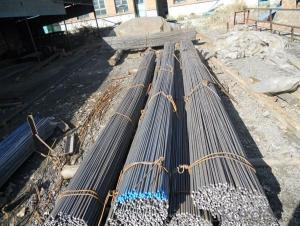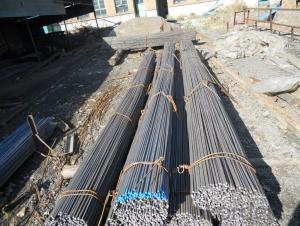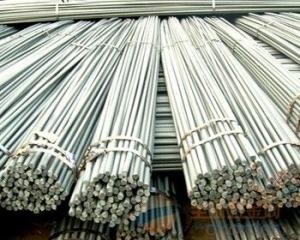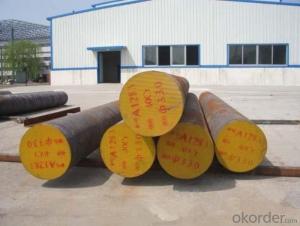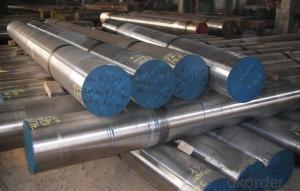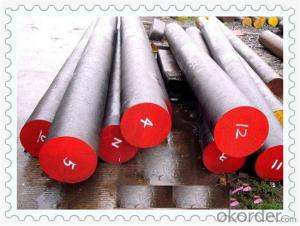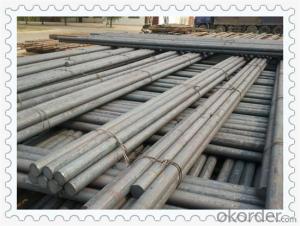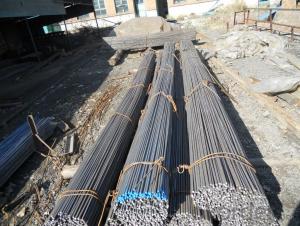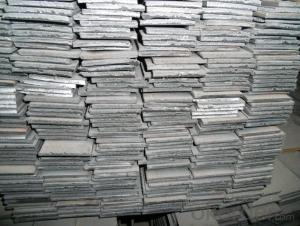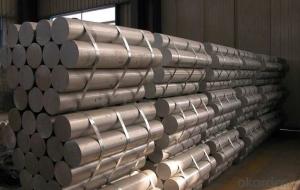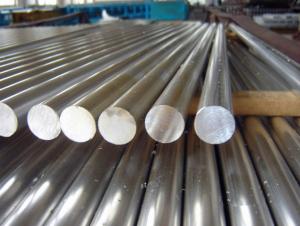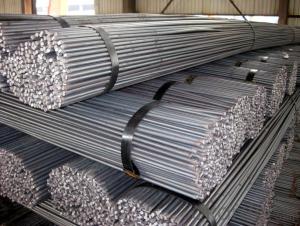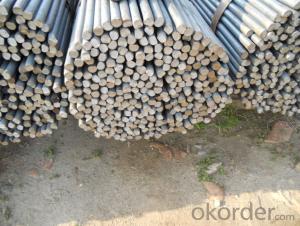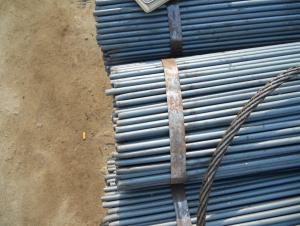stainless steel ; round bar steel ;steel rod
- Loading Port:
- Shanghai
- Payment Terms:
- TT OR LC
- Min Order Qty:
- 500 m.t.
- Supply Capability:
- 3000 m.t./month
OKorder Service Pledge
OKorder Financial Service
You Might Also Like
Product Description:

Stainless Steel Bar
Stainless Steel Round Bright Bar
Hot-rolled Stainless Steel Black Bar
Grades:201、202、301、302、303、304、316、316L、321 etc
Diameter (mm) | weight (kg/m) | Diameter (mm) | weight (kg/m) | Diameter (mm) | weight (kg/m) | Diameter (mm) | weight (kg/m) |
2 | 0.025 | 14 | 1.221 | 30 | 5.607 | 50 | 15.575 |
3 | 0.056 | 15 | 1.402 | 32 | 6.38 | 55 | 18.846 |
4 | 0.1 | 16 | 1.595 | 34 | 7.202 | 60 | 22.428 |
5 | 0.156 | 18 | 2.019 | 35 | 7.632 | 65 | 26.322 |
6 | 0.224 | 19 | 2.249 | 36 | 8.074 | 70 | 30.527 |
7 | 0.305 | 20 | 2.492 | 38 | 8.996 | 75 | 35.044 |
8 | 0.399 | 22 | 3.015 | 40 | 9.968 | 80 | 39.872 |
9 | 0.505 | 24 | 3.588 | 42 | 10.99 | 85 | 45.012 |
10 | 0.623 | 25 | 3.894 | 45 | 12.616 | 90 | 50.463 |
11 | 0.754 | 27 | 4.542 | 46 | 13.183 | 95 | 56.226 |
12 | 0.897 | 28 | 4.884 | 48 | 14.354 | 100 | 62.3 |
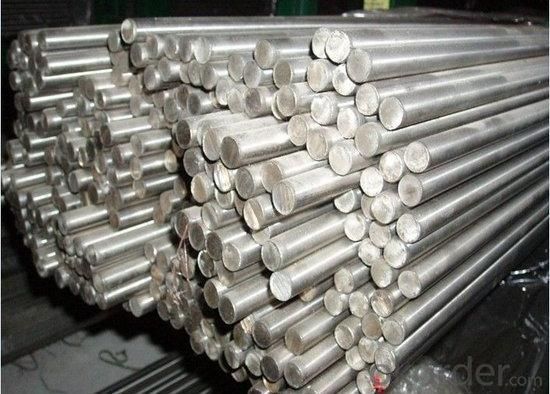
- Q: What is the difference between a smooth and a ribbed steel round bar?
- A smooth steel round bar is a solid cylindrical piece with a smooth surface, whereas a ribbed steel round bar has raised ridges or ribs along its length. The ribs on a ribbed bar provide better grip and adherence when used in construction and reinforcement applications, while the smooth bar is often used in applications where a sleek and polished appearance is desired.
- Q: What are the limitations of steel round bars?
- When selecting the appropriate material for a specific application, it is important to consider the limitations associated with steel round bars. Firstly, weight is a significant factor to consider. Steel round bars can be quite heavy, especially in larger diameters. This can pose challenges during transportation and installation, especially in situations where weight restrictions are a concern. Secondly, corrosion is another limitation of steel round bars. Although steel is known for its strength and durability, it is susceptible to rust and deterioration when exposed to moisture or certain chemicals. To mitigate this, protective coatings can be used or stainless steel round bars can be chosen as they are more resistant to corrosion. Thirdly, machinability is a challenge with steel round bars due to their high hardness and strength. This can result in increased tool wear, reduced cutting speeds, and longer machining times, leading to higher production costs. Cost is also an important consideration. Steel round bars, especially those made from high-quality alloys, can be relatively expensive compared to other materials. This cost factor may limit their use in applications with budget constraints. In terms of design flexibility, steel round bars come in standard sizes and shapes, which may restrict design options in some cases. Additional processing steps such as cutting or forging may be necessary to achieve a specific shape or size, adding to the overall production cost. Lastly, fatigue strength is a limitation of steel round bars. Although they have excellent strength properties, they can be prone to fatigue failure under repeated or cyclic loading. This is particularly relevant in applications where the material is constantly subjected to stress or vibration. Despite these limitations, steel round bars are still widely used in various industries due to their exceptional strength, reliability, and versatility. However, it is crucial to carefully consider these factors to ensure that the chosen material meets the specific requirements of the intended application.
- Q: How is the weight of a steel round bar calculated?
- To determine the weight of a steel round bar, one must employ a formula that incorporates the bar's diameter, length, and the density of the steel variant in question. The formula is as follows: Weight = (π/4) x (diameter)^2 x length x density Within this formula, the symbol π denotes the mathematical constant pi (approximately 3.14159), the diameter signifies the measurement across the broadest point of the round bar, the length refers to the measurement from one end of the bar to the other, and the density pertains to the mass per unit volume of the specific steel type. By substituting the values of diameter, length, and density into this formula, it becomes possible to compute the weight of a steel round bar. It is important to note that the weight will be expressed in units of mass, such as kilograms or pounds, depending on the adopted system of measurement.
- Q: How are steel round bars used in the construction of high-rise buildings?
- Steel round bars are commonly used in the construction of high-rise buildings due to their strength, durability, and versatility. These bars are typically made of carbon steel, which has excellent mechanical properties and can withstand high loads and pressures. In the construction of high-rise buildings, steel round bars are primarily used in reinforced concrete structures. They are commonly used as reinforcement in concrete beams, columns, and slabs. The bars are embedded in the concrete to provide additional strength and stiffness to the overall structure. One of the main advantages of using steel round bars is their ability to resist tension forces. Concrete is strong in compression but weak in tension, so the steel bars act as tension reinforcement, preventing the concrete from cracking or failing under tension loads. This helps to enhance the structural integrity and overall safety of the building. Additionally, steel round bars can be easily bent, shaped, and welded, allowing for flexible design and construction possibilities. They can be customized to specific lengths and diameters to suit the requirements of the building project. This versatility makes them ideal for constructing various structural elements, such as beams and columns, which need to be precisely engineered to support the weight and stresses of a high-rise building. Moreover, steel round bars have excellent resistance to corrosion, which is crucial in the construction of high-rise buildings that are exposed to various environmental elements. The corrosion-resistant properties of steel ensure the long-term durability and lifespan of the structure. Overall, steel round bars play a vital role in the construction of high-rise buildings by providing strength, durability, and flexibility to the reinforced concrete structures. They enhance the overall structural integrity, safety, and longevity of the building, making them an essential component in modern construction practices.
- Q: Are steel round bars prone to fatigue failure?
- Fatigue failure is a common occurrence in steel round bars, which can be attributed to repeated cyclic loading or stress. This leads to a gradual weakening of the material, eventually causing it to fail, even if the applied stress is below its ultimate strength. Due to their inherent characteristics, steel round bars, like other structural materials, are susceptible to fatigue failure. Various factors can contribute to fatigue failure in steel round bars, including improper design, inadequate material selection, manufacturing defects, and excessive cyclic loading. Additionally, surface defects, notches, stress concentrations, and corrosive environments can further accelerate the fatigue process. Engineers and designers take several measures to mitigate the risk of fatigue failure. These include implementing appropriate design practices, selecting high-quality materials, conducting thorough inspections, applying stress-relieving treatments, and considering the impact of cyclic loading during the structural design phase. It is important to understand that the susceptibility of steel round bars to fatigue failure depends on multiple factors, such as the specific steel grade, loading conditions, environmental factors, and overall structural design. Therefore, it is crucial to carefully assess these factors and employ appropriate mitigation measures to ensure the safe and reliable performance of steel round bars in various applications.
- Q: What are the properties of steel round bars?
- Steel round bars are widely used in various industries due to their numerous properties. Firstly, their strength and durability are highly recognized. Steel is known for its exceptional strength, which is retained in the round bar form. This makes steel round bars perfect for applications requiring high strength and toughness, such as construction, manufacturing, and engineering. Secondly, steel round bars possess excellent machinability. They can be easily cut, drilled, and shaped, making them adaptable for various projects. This characteristic allows for effortless fabrication and customization of the round bars to meet specific requirements. Moreover, steel round bars exhibit good corrosion resistance. They are often made from stainless steel or alloyed steel, enhancing their resistance to rust and other forms of corrosion. Consequently, they can be utilized in outdoor and harsh environments, where exposure to moisture and chemicals can potentially damage other materials. Another significant property of steel round bars is their exceptional thermal and electrical conductivity. This makes them suitable for applications that require efficient heat or electricity conduction, such as electrical systems or heat exchangers. Furthermore, steel round bars have a sleek and polished surface finish. This not only enhances their aesthetics but also improves their resistance to wear and tear. The smooth surface reduces friction and allows for easy movement or rotation, making steel round bars ideal for use in mechanical components and machinery. Lastly, steel round bars are available in a wide range of sizes, grades, and finishes. This provides flexibility in application and ensures the selection of the appropriate round bar based on specific requirements. In conclusion, the versatile and reliable nature of steel round bars, characterized by their strength, machinability, corrosion resistance, thermal and electrical conductivity, surface finish, and availability in various sizes and grades, make them a favored choice for numerous industrial applications.
- Q: Are steel round bars susceptible to rust?
- Yes, steel round bars are susceptible to rust if they are not properly protected or coated.
- Q: What are the tolerance standards for steel round bars?
- The tolerance standards for steel round bars differ based on specific requirements and industry norms. Generally, the tolerance for the diameter or size of steel round bars is specified as a plus or minus tolerance. This implies that the actual diameter of the bar may slightly deviate from the specified size, but it must fall within the specified tolerance range. In certain industries, like construction or manufacturing, the tolerance for steel round bars may be broader to facilitate easier fabrication and installation. For instance, a common tolerance range for the diameter of steel round bars used in construction could be ±0.005 to ±0.010 inches. In more precise applications, such as aerospace or automotive industries, the tolerance requirements for steel round bars are typically stricter. In these cases, the tolerance range can be significantly smaller, often ranging from ±0.001 to ±0.002 inches. It is important to note that different countries and organizations may have their own specific tolerance standards for steel round bars. These standards are usually outlined in industry-specific documents or specifications, such as ASTM (American Society for Testing and Materials) or ISO (International Organization for Standardization) standards. In summary, the tolerance standards for steel round bars vary depending on the specific requirements of the industry and application. The tolerance range for diameter can range from relatively broad to extremely tight, and these standards are typically defined by industry-specific organizations or standards bodies.
- Q: How do you calculate the weight of a steel round bar based on its volume and density?
- To calculate the weight of a steel round bar based on its volume and density, you can use the formula: weight = volume x density.
- Q: Can steel round bars be used in the production of electrical equipment?
- Yes, steel round bars can be used in the production of electrical equipment. Steel is a versatile material with various properties that make it suitable for different applications, including electrical equipment. Steel round bars can be used to manufacture components such as shafts, connectors, and structural supports in electrical equipment. The strength and durability of steel make it a reliable choice for these applications, as it can withstand the mechanical stresses and environmental conditions that electrical equipment may be exposed to. Additionally, steel can provide good electrical conductivity and magnetic properties, which are important characteristics for certain electrical components. However, it is worth noting that steel round bars may need to undergo additional processes such as machining, heat treatment, or surface finishing to meet specific requirements for electrical equipment production.
Send your message to us
stainless steel ; round bar steel ;steel rod
- Loading Port:
- Shanghai
- Payment Terms:
- TT OR LC
- Min Order Qty:
- 500 m.t.
- Supply Capability:
- 3000 m.t./month
OKorder Service Pledge
OKorder Financial Service
Similar products
Hot products
Hot Searches
Related keywords



